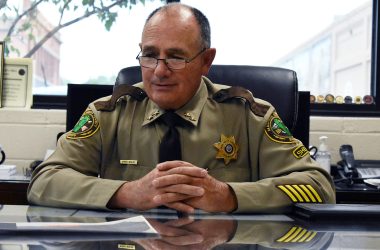
ONTARIO – Police say Ontario’s gang problem persists.
Police point to graffiti tags as proof gangs remain and solving the problem isn’t going to be easy.
That’s because one of the best solutions – police officers assigned to focus on gangs – will cost Ontario too much money.
The problem surfaced last year after a spate of shootings rocked Ontario. The first one occurred in early June 2017, when two men opened fire with a semi-automatic handgun on a parked car near the Ontario Train Depot.
The violence escalated in late fall when a succession of gang-related shootings sent three people to the hospital and shell casings littered city streets.
While the gang warfare seemed to stop, police said there is growing evidence of a new, homegrown criminal syndicate.
The new gang called SSL contends for power with Brown Magic Clica, often referred to as BMC and which can trace its roots to Nyssa and California, the 18th Street Gang, and the Nortenos.
Ontario police officer Tomas Elizondo, the department’s former gang officer, said so far this year police recorded 96 gang related cases – almost all of them graffiti. In 2017, Ontario police logged 124 gang-related graffiti incidents.
During the past few months, he said, graffiti incidents have climbed.
“We’ve seen a lot of tagovers where one gang comes and writes something then a second gang comes in puts their graffiti over that,” said Elizondo.
The graffiti cases, said Elizondo, are noteworthy because of what they mean.
“What has me concerned is the frequency of it. It shows they are getting more active. And when you tag over someone’s graffiti you are disrespecting the other gang and that leads, usually, to violence. They are posturing,” said Elizondo.
He said he doesn’t know much about the new gang but its appearance is troubling “because they are trying to get started and you already have active gangs in the area. So, they are going to have to do something that makes them special from the others to prove themselves.”
Gang members and those who associate with them are notoriously tight-lipped when police try to investigate. That means gang crimes usually go unsolved.
An officer focused only on gangs would help Ontario police but that isn’t going to happen any time soon, said Mayor Ron Verini. The gang officer slot was cut to save money.
“To have a gang officer with the amount of workload they have right now and the amount of money we have to pay them do not coincide,” said Verini.
Verini said the Ontario City Council created a $5 public safety fee earlier this year just to retain two police officers.
“There is a danger in the community and we don’t have enough money to fight it,” said Verini of the gang threat.
Elizondo, for example, is a school resource officer but because he used to be the gang officer, he spends what time he can on battling gangs.
The choice isn’t easy, said Darrel Patzer, a senior parole and probation officer with Malheur County Corrections.
“Do you have a gang officer or do you make sure you have enough people to respond to calls for services?” said Patzer.
Brian Wolfe, Malheur County sheriff, said a gang officer gives police more options.
“The nice thing about a designated person on gang activity is they do get more intel,” said Wolfe.
Verini said police can fight the gang problem by “being more proactive.”
Wolfe said being proactive for police means putting more focus on gang activities.
“You know, or have a pretty good idea, who is doing what so that is who gets the most attention from law enforcement. You give that additional attention often times they want to move their activity,” said Wolfe.
There isn’t one solution to the problem, Patzer said.
“Some things don’t have an answer. They have a temporary fix,” he said. Gangs represent “a lifestyle, a viewpoint and you don’t change people’s hearts and minds externally.”
Gustavo Morales, the executive director of EUVALCREE in Ontario, said a united effort between police and residents is the only way to solve the gang problem.
“It (the gang problem) shows how vulnerable our youth are to being recruited because of the lack of opportunities in our community,” said Morales.
Reporter Pat Caldwell: [email protected] or 541-473-3377.




